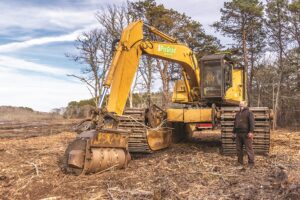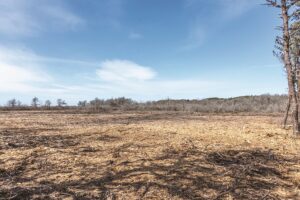WELLFLEET — Deep into the dense brush of Duck Harbor, a low rumbling sound reverberates off the pitch pines and oak trees. An enormous yellow machine munches through the understory, and seated in the cab, half hidden by equipment, a brawny man with mutton chops has his hand on the throttle.
Faun Koplovsky is his name, and turning trees into mulch is his game. The man with the mythical name is doing the work that has everyone talking: the utter obliteration of 125 acres of vegetation at Duck Harbor that was killed in the great overwash event of December 2020.
“My job is pretty wild,” Koplovsky said, perched next to his towering ProGrind excavator, whose slogan is “We eat trees for lunch.”
“I deal with the worst of the worst a lot of the time,” Koplovsky said. “I built my machine to not have a limit. There’s no limit to what it can mulch. I can mulch every single thing. That’s what sets me apart from other folks in the mulching business.”

Koplovsky was contracted by the Tennessee-based nonprofit Ducks Unlimited, which received a $2-million grant from the U.S. Fish and Wildlife Service to manage vegetation removal at Duck Harbor. The removal is part of the Herring River project, the largest saltwater marsh restoration project in Massachusetts history, which aims to restore tidal flow and saltwater habitats in the 1,000-acre estuary.
Koplovsky’s work at Duck Harbor began in late January and will end on April 15 when the endangered Northern long-eared bat returns to the area from winter hibernation. Federal and state regulations prohibit the removal of trees in known habitat areas during bat-roosting season.
But he will be back in November to finish what he started. He has already leveled 50 acres of salt-poisoned trees and shrubbery, and he pulverizes about three more acres every day, depending on the size of the trees. “Machine hydraulics is what I listen to all day,” Koplovsky said. “It’s my music.”
Koplovsky has been in the game for 20 years, with over 25,000 hours of mulching experience, he estimated. Despite his expertise, “It never gets boring. Mulching trees is just my thing, I guess.”
Originally from Randolph, Vt., Koplovsky said his decision to enter the industry was a no-brainer: “I just saw someone working on the side of the road with a tree mulcher and thought it was pretty wild.”
He has worked on projects across the Northeast, including trail-clearing in the Vermont National Forest, tree-mulching for prescribed burns on Long Island, and brush-masticating in Mashpee to help restore New England cottontail habitat.
“I’m like an earth artist,” Koplovsky said. “A lot of what I do is forest grooming, stump grinding. I beautify the land.”
But the Duck Harbor project is a first for him. “I’m kind of a mountain goat,” he said. “I’ve never worked in a saltwater marsh, so it’s pretty wild to see the ocean while I’m mulching trees.”
He added that he has “never dealt with so many big dead trees. These are challenging trees. They’ve been struggling their whole lives to survive, so they’re very strong, which makes them tougher to mulch.”
Because Duck Harbor was, in fact, a harbor (and then a salt marsh) before the Herring River was diked in 1909 draining much of the estuary of salt water, the area still retains a swampy topsoil. This makes it harder for most machinery to traverse the basin.

Koplovsky’s excavator sports two pontoons on the bottom that have a ground impact of one pound per square inch. “They call it a marsh buggy undercarriage,” Koplovsky said. “A floating excavator is pretty wild.”
But you can’t just get them anywhere, he said. He went to New Orleans to buy the pontoons, and with the help of a couple of mechanics and a crane lugged the 20-by-35-foot machinery back across the Mason-Dixon line. “I now believe I’m the only guy in the Northeast with a marsh buggy undercarriage,” Koplovsky said.
The machine’s head is specialized, too. With a hydraulically powered rolling drum, its sharp teeth can masticate wood with speed and efficiency.
But despite appearances, the job isn’t all about death and destruction. “It’s regenerative,” Koplovsky said. “The whole cool idea here is that the mulch goes right back into the soil, so it’s going to help build the soil for when the saltwater marsh comes in.”
Before the Herring River was diked in 1909, Duck Harbor was navigable. Early settlers floated building materials to Bound Brook Island. But by the late 1800s, the harbor had “shoaled off” into a healthy salt marsh.
When the dike was constructed, berms and ditches were also built to drain the marsh for mosquito control. Freshwater vegetation and invasive species like phragmites then colonized the area, turning it into a dense freshwater wetland.
When a nor’easter hit the coast in December 2020, high tides breached the already-eroding sand dunes at Duck Harbor Beach, and salt water flowed into the basin, killing off the freshwater species there. Since then, high tides regularly breach the dunes and flow into the basin, furthering the dieback.
Koplovsky’s job is to remove the dead vegetation and berms so that when the dike is opened tidal flow through the estuary will reconstitute Duck Harbor as a saltwater marsh. Tim Smith, a restoration ecologist for the Cape Cod National Seashore, said that researchers saw native salt-marsh species like cordgrass arriving last summer as well as seed banks and propagules washed over from the tides. The removal of dead freshwater vegetation will promote the repopulation of the salt-marsh understory, Smith said.
“It’s all about restoration,” Koplovsky said, looking out at the vast expanse of open land where just a few months ago a mass of dead trees stood — and many years before that, where a salt marsh sprouted cordgrass and where herring spawned. Sometime in the future, with the help of Koplovsky and his giant machine, it could look like that again.
“It’s pretty wild,” Koplovsky said.



